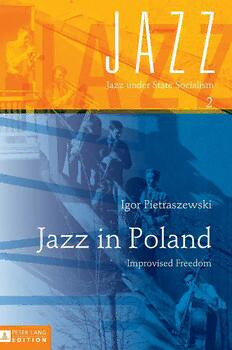
Jazz in Poland: Improvised Freedom (Jazz under State Socialism) PDF
Preview Jazz in Poland: Improvised Freedom (Jazz under State Socialism)
Jazz in Poland JAZZ Jazz under State Socialism Edited by Gertrud Pickhan and Rüdiger Ritter Vol. 2 Igor Pietraszewski Jazz in Poland Improvised Freedom Translated by Lucyna Stetkiewicz Bibliographic Information published by the Deutsche Nationalbibliothek The Deutsche Nationalbibliothek lists this publication in the Deutsche Nationalbibliografie; detailed bibliographic data is available in the internet at http://dnb.d-nb.de. This publication was financially supported by the Faculty of Social Sciences, University of Wrocław. Imprint of the cover illustration by courtesy of Marek A. Karewicz, Warszawa. First edition in Polish as “Wolność improwizowana” by NOMOS Publishing House, Kraków, Poland 2012. Library of Congress Cataloging-in-Publication Data Pietraszewski, Igor, 1962- author. [Jazz w Polsce. English] Jazz in Poland : improvised freedom / Igor Pietraszewski. pages cm. — (Jazz under state socialism, 1867-724X ; vol. 2) Translation of Jazz w Polsce : wolność improwizowana. Kraków : Nomos, c2012. Includes bibliographical references and index. ISBN 978-3-631-64319-8 1. Jazz—Social aspects—Poland. 2. Jazz—Economic aspects. 3. Jazz— Poland—History and criticism. 4. Music and state—Poland. I. Title. ML3918.J39P5413 2014 781.6509438—dc23 2013047996 ISSN 1867-724X ISBN 978-3-631-64319-8 (Print) E-ISBN 978-3-653-03276-5 (E-Book) DOI 10.3726/978-3-653-03276-5 © Peter Lang GmbH Internationaler Verlag der Wissenschaften Frankfurt am Main 2014 All rights reserved. Peter Lang Edition is an Imprint of Peter Lang GmbH. Peter Lang – Frankfurt am Main · Bern · Bruxelles · New York · Oxford · Warszawa · Wien All parts of this publication are protected by copyright. Any utilisation outside the strict limits of the copyright law, without the permission of the publisher, is forbidden and liable to prosecution. This applies in particular to reproductions, translations, microfilming, and storage and processing in electronic retrieval systems. This book is part of the Peter Lang Edition list and was peer reviewed prior to publication. www.peterlang.com Contents Preface ................................................................................................................... 9(cid:1) Introduction ......................................................................................................... 11(cid:1) Chapter I The world of jazz in the light of Pierre Bourdieu’s theory ............................ 17(cid:1) The habitus .................................................................................................. 22(cid:1) The capital ................................................................................................... 25(cid:1) The field ...................................................................................................... 28(cid:1) Chapter II Evolution of the field of jazz in Poland ........................................................... 35(cid:1) Before World War II ................................................................................... 39(cid:1) War occupation 1939-1945 ......................................................................... 46(cid:1) 1945-1948 ................................................................................................... 48(cid:1) 1948-1956 ................................................................................................... 52(cid:1) 1956-1970 ................................................................................................... 63(cid:1) 1970-1981 ................................................................................................... 74(cid:1) 1981-1989 ................................................................................................... 78(cid:1) After the year 1989 ...................................................................................... 81(cid:1) Chapter III Habitus of the jazzman ..................................................................................... 85(cid:1) Chapter IV The modern audience of jazz .......................................................................... 117(cid:1) Socio-demographic profile ........................................................................ 118(cid:1) The ways of “entering jazz” and the audience’s preferences ....................... 120(cid:1) Typology of jazz listeners ......................................................................... 129(cid:1) Participation in the field of jazz ................................................................ 135(cid:1) Summary ................................................................................................... 140(cid:1) Final Conclusions .............................................................................................. 143(cid:1) List of tables ...................................................................................................... 145(cid:1) Index .................................................................................................................. 147(cid:1) Bibliography ...................................................................................................... 151(cid:1) To my Mother Preface The communist system, even during its waning years, had an ambition of con- trolling as many aspects of its citizens’ lives as possible. The power was there- fore exercised in three ways: economically (command economy), politically (the party-state that eliminated political competition), and culturally (through the mechanisms of preventive censorship and the attempts to cultivate a single cul- tural form: socialist realism). Economically the state controlled the “means of production,” to use Marxist parlance, and there was not much people could do once private businesses were either eliminated or pushed to margins of the economic life. Politically, chal- lenging the power of the party-state was extremely risky and only a few decided to engage in dissident activities. The only domain whereby opposition could have been formulated and even expressed, particularly if criticism was carefully veiled by metaphors or concealed in Aesopian fables, was culture. As a result, people were well versed in interpreting cultural productions as expressions of freedom and critiques of the oppressive system, even if there was no explicit intention to challenge the system on the part of the artists. Music had a special role in this “hidden” criticism, as it is not difficult to endow an instrumental piece with a meaning. All one needs is imagination. And that was never in short supply under communism. Jazz was particularly suitable to serve as a conduit of “hidden” rebellion. Its very form is rebellious. It is after all an epitome of freedom, as improvisation is right at its center. Additionally, after 1956, Poland was gradually becoming the freest of the communist countries. The rulers simply did not have enough re- sources to control all aspects of social and private life; arguably some of them did not want to be too strict. There was the Catholic Church, never completely subjugated. And than there were cabarets, theatres, clubs… And many of these clubs were full of music and the music of choice was often jazz. This musical form literally exploded in Poland in the late 1950s and managed to preserve its popularity until the beginning of the eighties. There existed, however, a peculiar paradox. Jazz managed to acquire a status of rebellious, free music, and yet jazz musicians enjoyed the benefits of state sponsorship. Where was the line between rebellion and subservience? Pietraszewski offers interesting answer this question. In the process he writes also a history of jazz music in Poland, going back to the interwar period (1918-39) and analyzing the situation of jazz musicians after the fall of com- munism, when they had to learn very quickly how to survive under the market conditions.
